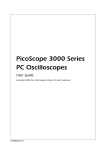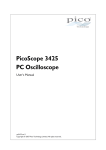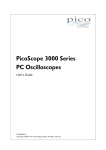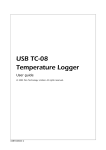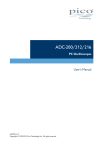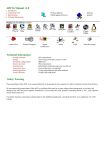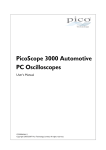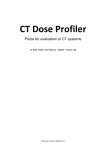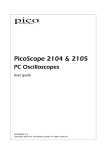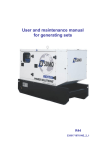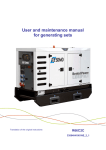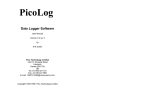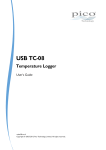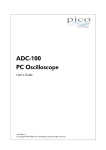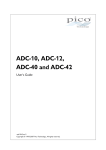Download PicoScope 3000 Series Help
Transcript
PicoScope 3000 series User guide Copyright 2004 Pico Technology Limited. All rights reserved. I PicoScope 3000 Series Help Table of Contents Part I Introduction 1 Overview 3 ................................................................................................................................... 3 2 Installation instructions ................................................................................................................................... 3 3 Safety symbols ................................................................................................................................... 4 4 Safety warning ................................................................................................................................... 5 5 FCC notice ................................................................................................................................... 6 6 CE notice ................................................................................................................................... 6 7 Company details ................................................................................................................................... 7 Part II Product information 8 1 Specifications................................................................................................................................... 8 2 Minimum system ................................................................................................................................... requirements 9 Part III Advanced features 10 1 Sampling modes ................................................................................................................................... 10 2 More on block ................................................................................................................................... mode 10 3 More on streaming ................................................................................................................................... mode 10 4 Triggering ................................................................................................................................... 11 5 ETS (Equivalent ................................................................................................................................... Time Sampling) 11 6 Voltage ranges ................................................................................................................................... 11 7 AC/DC operation ................................................................................................................................... 11 8 Oversampling ................................................................................................................................... 11 9 Scaling ................................................................................................................................... 11 10 Signal generator ................................................................................................................................... 12 11 Combining oscilloscopes ................................................................................................................................... 12 Part IV Using different modes 13 1 Introduction ................................................................................................................................... 13 2 Using block ................................................................................................................................... mode 13 3 Using streaming ................................................................................................................................... mode 13 4 Using ETS mode ................................................................................................................................... 13 Part V Technical reference 15 1 Driver ................................................................................................................................... 15 2 Functions ................................................................................................................................... 15 3 Programming ................................................................................................................................... 25 4 Glossary ................................................................................................................................... 27 Part VI Troubleshooting 30 Copyright 2004 Pico Technology Limited. All rights reserved. Contents 1 FAQ II ................................................................................................................................... 30 2 Error codes ................................................................................................................................... 30 Index 32 Copyright 2004 Pico Technology Limited. All rights reserved. II 3 PicoScope 3000 Series Help 1 Introduction 1.1 Overview The PicoScope 3000 series is a range of high speed PC oscilloscopes, fully USB 2.0 capable and backwards compatible with USB 1.1. There is no need for an additional power supply, as power input is from the USB port: these oscilloscopes are highly portable. With the PicoScope software, oscilloscopes from the PicoScope 3000 series can be used as PC oscilloscopes and spectrum analyzers; with the PicoLog software, oscilloscopes from the PicoScope 3000 series can be used as data loggers. Alternatively, you might want to use some of the API functions to develop your own programs to collect and analyze data from the oscilloscope. A typical PicoScope 3000 oscilloscope is supplied with the following items: USB cable, for use with both types of USB port Software CD Installation guide 1.2 Installation instructions Warning: Do not connect an oscilloscope from the PicoScope 3000 series to the PC until the software has been installed. Install the software by following the steps in the installation guide supplied with your oscilloscope. Your oscilloscope is connected to the PC with the USB cable supplied. There is no need for an additional power supply as power is drawn from the USB port. Checking the installation Once the software has been installed, ensure that the oscilloscope is connected to the PC and start up the PicoScope or PicoLog software. The software should now display the voltage that you have connected. If you are using a scope probe and PicoScope, you should see a small 50Hz or 60Hz mains signal in the oscilloscope window when you touch the scope probe tip with your finger . Standard oscilloscope connectors PicoScope 3000 series oscilloscopes have standard oscilloscope connectors. The input impedance is also standard, so the x10 function on scope probes works correctly. The BNC connector, labelled 3 on the diagram below, 'E' on the oscilloscope, has two functions. In normal use it is the external trigger input with an adjustable threshold. Alternatively, on some oscilloscopes, this connector can also be used to output sine, square and triangle waveforms which can be swept back and forth at a user-defined frequency. The integrated signal generator can be controlled via the PicoScope software or by API calls. The signal generator can also be used to compensate x10 scope probes when set to output a square wave. Copyright 2004 Pico Technology Limited. All rights reserved. Introduction 4 Connector diagram 1 USB port connector 2 LED. When lit, indicates the PicoScope 3000 series oscilloscope is sampling data 3 External trigger / Signal generator 1.3 Safety symbols Symbol 1: Warning Triangle This symbol indicates that a safety hazard exists on the indicated connections if correct precautions are not taken. Ensure that all safety documentation associated with the product is read in detail before a product is used. Copyright 2004 Pico Technology Limited. All rights reserved. 5 PicoScope 3000 Series Help Symbol 2: Equipotential This symbol indicates that the outer shell of the indicated BNC connectors are all at the same potential (i.e. are shorted together). The user must therefore take necessary precautions to avoid a potential being applied across the return connections of the indicated BNC terminals as this may result in a large current flow causing damage to the product and/or connected equipment. 1.4 Safety warning We strongly recommend that you read the general safety information below before using your oscilloscope for the first time. Safety protection built in to equipment may cease to function if the equipment is used incorrectly. This could cause damage to your computer, or lead to injury to yourself and others. Maximum input range Oscilloscopes from the PicoScope 3000 range are designed to measure voltages in the range -20V to +20V. Any voltages in excess of ±100V may cause physical damage. Mains voltages Pico Technology products are not designed for use with mains voltages. To measure mains, use a differential isolating probe specifically designed for a high source voltage. Safety grounding PicoScope 3000 series oscilloscopes connect direct to the ground of a computer via the interconnecting cable provided. This method minimises interference. As with most oscilloscopes, avoid connecting the ground input to any source other than ground. If in doubt, use a meter to check that there is no significant AC or DC voltage. Failure to check may cause damage to your computer, or lead to injury to yourself and others. You should assume that the product does not have a protective safety earth. Repairs The oscilloscope contains no serviceable parts: repair or calibration of the oscilloscope requires specialised test equipment and must be performed by Pico Technology. Copyright 2004 Pico Technology Limited. All rights reserved. Introduction 1.5 6 FCC notice This device complies with part 15 of the FCC Rules. Operation is subject to the following two conditions: (1) This device may not cause harmful interference (2) This device must accept any interference received, including interference that may cause undesired operation This equipment has been tested and found to comply with the limits for a Class B digital device, pursuant to part 15 of the FCC Rules. These limits are designed to provide reasonable protection against harmful interference in a residential installation. This equipment generates, uses and can radiate radio frequency energy and, if not installed and used in accordance with the instructions, may cause harmful interference to radio communications. However, there is no guarantee that interference will not occur in a particular installation. If this equipment does cause harmful interference to radio or television reception, which can be determined by turning the equipment off and on, the user is encouraged to try to correct the interference by one or more of the following measures: Reorient or relocate the receiving antenna Increase the separation between the equipment and receiver Connect the equipment into an outlet on a circuit different from that to which the receiver is connected Consult the dealer or an experienced radio/TV technician for help For safety and maintenance information see the safety warning. 1.6 CE notice The PicoScope 3000 series of PC oscilloscopes meets the intent of the EMC directive 89/336/EEC and the following standard has been applied: EN61326-1 (1997) Class A Emissions and Immunity. Products from the PicoScope 3000 range also meet the intent of the Low Voltage Directive and the following standard has been applied: BS EN 61010-1:2001 IEC 61010-1:2001 (safety requirements for electrical equipment, control, and laboratory use) Copyright 2004 Pico Technology Limited. All rights reserved. 7 1.7 PicoScope 3000 Series Help Company details Address: Pico Technology Limited The Mill House Cambridge Street St Neots Cambridgeshire PE19 1QB United Kingdom Phone: +44 (0)1480 396395 Fax: +44 (0)1480 396296 Email: Technical Support [email protected] Sales [email protected] Web site: www.picotech.com Copyright 2004 Pico Technology Limited. All rights reserved. Product information 2 Product information 2.1 Specifications 8 PicoScope 3204 PicoScope 3205 PicoScope 3206 8 bit 8 bit 8 bit ANALOG BANDWIDTH 50 MHz 100 MHz 200 MHz MAXIMUM SAMPLING RATE Single channel Dual channel Repetitive signals 50 MS/s 50 MS/s 2.5 GS/s 100 MS/s 100 MS/s 5 GS/s 200 MS/s 100 MS/s 10 GS/s 50 MHz 100 MHz 150 MHz 256 k 128 k 512 k 256 k 1M 512 k VERTICAL RESOLUTION TRIGGER BANDWIDTH BUFFER SIZE Single channel Dual channel 2 channels via BNC 1 MW impedance AC/DC coupling 20 pF input capacitance INPUTS OUTPUTS Signal generator 1 BNC shared with external trigger Fixed frequency 1 kHz 5 V square wave 600 W output impedance External trigger VOLTAGE RANGES ACCURACY OPERATING ENVIRONMENT Temperature range Humidity OVERLOAD PROTECTION Channels External trigger PC CONNECTION POWER SUPPLY 1 BNC shared with external trigger Variable frequency 1 Hz to 1 MHz 5 V square wave 1 V sine wave and triangle functions Repeat sweep function Dual slope function 600 W output impedance 1 BNC output shared with signal generator Variable trigger threshold ± 20 V rising/falling 12.2 mV resolution 1 MW impedance ± 100 mV to ± 20 V ranges in 1, 2, 5 steps 3 % voltage 100 ppm time 0°C to 70°C (25°C for quoted accuracy) 25% to 75% RH ± 50 V ± 30 V USB 2.0 Compatible with USB 1.1 From USB port: 4.6 to 5.25 V; 500 mA External power supply is not required DIMENSIONS 140 mm x 190 mm x 45 mm COMPLIANCE CE standard; FCC standard Copyright 2004 Pico Technology Limited. All rights reserved. 9 2.2 PicoScope 3000 Series Help Minimum system requirements For oscilloscopes from the PicoScope 3000 series to operate, a computer with the minimum system requirements to run Windows or the following (whichever is the higher specification) is required: Processor Pentium class processor or equivalent minimum. Memory 32 MB minimum. Disk space 10 MB minimum. Operating system Microsoft Windows 98 SE, ME, Microsoft Windows 2000, XP or later. Ports USB 1.1 compliant port minimum. USB 2.0 compliant port recommended. Must be connected direct to the port or a powered USB hub. Will not work on a passive hub. Copyright 2004 Pico Technology Limited. All rights reserved. Advanced features 3 Advanced features 3.1 Sampling modes 10 PicoScope 3000 series oscilloscopes run in various sampling modes. At high sampling rates, the PicoScope 3000 series oscilloscope will collect data much faster than a PC can read it. To compensate for this, the oscilloscope stores a block of data in an internal memory buffer, delaying transfer to the PC until the required number of data points have been sampled. This is called block mode. At very low sampling rates, you may want to switch to streaming mode. This allows data to be transferred back to the PC as it is collected. 3.2 More on block mode In block mode, the computer prompts an oscilloscope from the PicoScope 3000 series to collect a block of data into its internal memory. When the PicoScope 3000 series oscilloscope has collected the whole block, it will signal it is ready, and transfer the whole block into computer memory via the USB port. The maximum number of values depends upon the size of the oscilloscope's memory. A PicoScope 3000 series oscilloscope can sample at a number of different rates. These rates correspond to the maximum clock frequency multiplied by 0.5, 0.25, 0.125, and so on. There are 14 sampling rates. There is a separate memory buffer for each channel. When a channel is unused, its memory can be utilised by the enabled channels. On the faster models, one input can be routed to two circuits in the oscilloscope, thus doubling the effective sampling rate of a single channel. The driver for a PicoScope 3000 series oscilloscope normally performs a number of setup operations before collecting each block of data. This can take up to 50 milliseconds. If it is necessary to collect data with the minimum time interval between blocks, avoid calling setup functions between calls to ps3000_run_block(), ps3000_ready (), ps3000_stop() and ps3000_get_values (). 3.3 More on streaming mode In streaming mode, the computer prompts the PicoScope 3000 series oscilloscope to start collecting data. The data is then transferred back to the PC without being stored in oscilloscope memory. Data can be sampled with a period of between 1 ms and 60 s. Data can be transferred by the oscilloscope's driver to a computer program either in normal or windowed mode. In normal mode, any data collected since the last data transfer operation is returned in its entirety. In windowed mode, a fixed number (n) of samples is returned, where the oldest samples may have already been returned before. Normal mode is useful if the computer program requires fresh data on every transfer. Windowed mode is useful when the program requires a constant time frame of data. Once the oscilloscope is collecting data in streaming mode, any setup changes (for example, changing a channel range or AC/DC setting in the PicoScope software application) will cause a restart of the data stream. The driver can buffer up to 32K samples of data per channel, but the user must ensure that the ps3000_get_values () function is called frequently enough to avoid buffer overrun. Copyright 2004 Pico Technology Limited. All rights reserved. PicoScope 3000 Series Help 11 The ps3000_get_times_and_values () function will always return FALSE (0) in streaming mode. 3.4 Triggering The PicoScope 3000 series oscilloscope can either start collecting data immediately, or it can be programmed to wait for a trigger event to occur. In either case, you need to use the ps3000_set_trigger () function. A trigger event can occur when the channel A or B input crosses a threshold voltage, or when an external trigger input crosses a threshold voltage. The trigger event can be either a rising or a falling edge. The external trigger input uses the same physical connection as the signal generator output, so these two functions cannot be used at the same time. It is possible, however, to use the output from the signal generator as a trigger. Triggering is available in block mode only. Any calls to the ps3000_set_trigger () function has no effect in streaming mode. 3.5 ETS (Equivalent Time Sampling) ETS is a way of increasing the effective sample rate when working with repetitive signals. It is not possible to use ETS with one-shot signals. ETS is controlled via use of the ps3000_set_trigger () and ps3000_set_ets() functions. ETS is available in block mode only. Calls to the ps3000_set_trigger () function have no effect in streaming mode. As ETS will return random time intervals, the ps3000_get_times_and_values () function must be used. The ps3000_get_values () function will return FALSE (0). 3.6 Voltage ranges It is possible to set the gain for each channel with the ps3000_set_channel() function. This will give an input voltage range of between 100mV and 20V. The external trigger has a fixed input range of 20V. 3.7 AC/DC operation Using the ps3000_set_channel function, each channel can be set to either AC or DC coupling. When AC coupling is used, any DC component of the signal is filtered out. 3.8 Oversampling When the oscilloscope is operating in block mode at speeds that are less than maximum, it is possible to oversample. Oversampling is taking more than one measurement during a time interval and returning an average. This reduces the effects of noise, and increases the resolution of the oscilloscope. 3.9 Scaling Oscilloscopes from the PicoScope 3000 series are 8-bit. To take advantage of noise reduction due to oversampling (if enabled), the oscilloscope driver returns 16-bit readings. The following table shows the relationship between the reading from the driver and the voltage of the signal. Reading Voltage -32767 Minimum 0 Zero volts 32767 Maximum Copyright 2004 Pico Technology Limited. All rights reserved. Advanced features 3.10 12 Signal generator PicoScope 3000 series oscilloscopes have a built-in signal generator which is set using ps3000_set_siggen (). It produces a selection of accurate frequencies from 1Hz to 1MHz. The waveform can be set to sine, square or triangle and can be swept back and forth in frequency. These are selected under software control. The signal generator output is physically the same as the external trigger input, so these two functions cannot be used at the same time. It is possible, however, to use the output from the signal generator as a trigger. Note: The signal generator function is not available on all PicoScope 3000 series oscilloscopes. 3.11 Combining oscilloscopes With PicoLog or your own program it is possible to collect data using up to four oscilloscopes from the PicoScope 3000 series at the same time. Each oscilloscope must be connected to a separate USB port. If a USB hub is used it must be a powered hub. The ps3000_open_unit () function returns a handle to an oscilloscope. All of the other functions require this handle for oscilloscope identification. For example, to collect data from two oscilloscopes at the same time: handle1 = ps3000_open () handle2 = ps3000_open () ps3000_set_channel (handle1) ... set up unit 1 ps3000_run(handle1) ps3000_set_channel (handle2) ... set up unit 2 ps3000_run(handle2) ready = FALSE while not ready ready = ps3000_ready (handle1) ready &= ps3000_ready (handle2) ps3000_get_values(handle1) ps3000_get_values(handle2) Note: It is not possible to synchronise the collection of data between oscilloscopes when you are using them in combination. Copyright 2004 Pico Technology Limited. All rights reserved. PicoScope 3000 Series Help 13 4 Using different modes 4.1 Introduction The previous section on advanced features aimed to supply the programmer with extended information on PicoScope 3000 series oscilloscopes. The C sample program, ps3000con.c, demonstrates how to use the functions of the driver software, and includes examples showing how to use each of the modes available. 4.2 Using block mode This is the general procedure for reading and displaying data in block mode: 1 Open the oscilloscope using ps3000_open_unit 2 Select channel ranges and AC/DC switches using ps3000_set_channel 3 Using ps3000_set_trigger, set the trigger if required 4 Using ps3000_get_timebase, select timebases until the required ns per sample is located 5 If required, set the signal generator frequency using ps3000_set_siggen 6 Start the oscilloscope running using ps3000_run_block 7 Wait until the oscilloscope says it is ready using ps3000_ready 8 Transfer the block of data from the oscilloscope using ps3000_get_values or ps3000_get_times_and_values 9 Display the data 10 Repeat steps 6 to 9 11 Stop the oscilloscope using ps3000_stop 4.3 Using streaming mode This is the general procedure for reading and displaying data in streaming mode: 1 2 3 4 5 6 7 4.4 Open the oscilloscope using ps3000_open_unit Select channel ranges and AC/DC switches using ps3000_set_channel Start the oscilloscope running using ps3000_run_streaming Transfer the block of data from the oscilloscope using ps3000_get_values Display the data Repeat steps 3 to 5 as necessary Stop the oscilloscope using ps3000_stop Using ETS mode This is the general procedure for reading and displaying data in ETS mode: 1 2 3 4 5 6 7 8 Open the oscilloscope using ps3000_open_unit Select channel ranges and AC/DC switches using ps3000_set_channel Using ps3000_set_trigger, set the trigger if required Set ETS mode using ps3000_set_ets Start the oscilloscope running using ps3000_run_block Wait until the oscilloscope says it is ready using ps3000_ready Transfer the block of data from the oscilloscope using ps3000_get_times_and_values Display the data Copyright 2004 Pico Technology Limited. All rights reserved. Using different modes 9 Repeat steps 5 to 8 as necessary 10 Stop the oscilloscope using ps3000_stop Copyright 2004 Pico Technology Limited. All rights reserved. 14 15 PicoScope 3000 Series Help 5 Technical reference 5.1 Driver The Windows 98SE/ME/2K/XP/2003 32-bit driver, picopp.sys, is installed in Windows, It is loaded using an inf file, picopp.inf. Once you have installed the PicoScope and PicoLog software, and the PicoScope 3000 oscilloscope is plugged in for the first time, Windows will automatically install the driver. 5.2 Functions 5.2.1 ps3000_open_unit short ps3000_open_unit ( void) This function opens an oscilloscope from the PicoScope 3000 series. The API driver can support up to four oscilloscopes. Arguments None. Returns -1 if the oscilloscope fails to open, 0 if no oscilloscope is found or a positive (>0) handle to the device opened. 5.2.2 ps3000_get_unit_info short ps3000_get_unit_info (short handle, char * string, short string_length, short info ) This function writes oscilloscope information to a character string. If the oscilloscope fails to open, only infos 0 and 6 are available to explain why the last open unit call failed. Copyright 2004 Pico Technology Limited. All rights reserved. Technical reference Arguments 16 handle, the handle to the device from which info is required. If an invalid handle is passed, the error code from the last unit that failed to open is returned from line 2. * string, a pointer to the character string buffer in the calling function where the unit information string (selected with line) will be stored. If a null pointer is passed, no information will be written. string_length, the length of the character string buffer. If the string is not long enough to accept all of the information, only the first string_length characters are returned. info, is an enumerated type specifying what information is required from the driver. Returns The length of the string written to the character string buffer, string, by the function. If one of the parameters are out of range, or a null pointer is passed for string, zero will be returned. info Description Example PS3000_DRIVER_VERSION (0) Returns the version number of the DLL used by the oscilloscope driver. "1, 0, 0, 2" PS3000_USB_VERSION (1) "1.1" or "2.0" Returns the type of USB connection that is being used to connect the oscilloscope to the computer. PS3000_HARDWARE_VERSION Returns information about what is ( 2) the hardware version of the attached oscilloscope. "1" PS3000_VARIANT_INFO (3) "3206" Returns information about what model of PicoScope 3000 series oscilloscope is attached to the computer. PS3000_BATCH_AND_SERIAL Returns the batch and serial number ( 4) of the oscilloscope. "CMY66/052" PS3000_CAL_DATE (5) Returns the calibration date of the oscilloscope. "21Oct03" PS3000_ERROR_CODE (6) Returns one of the Error codes. "4" Copyright 2004 Pico Technology Limited. All rights reserved. 17 5.2.3 PicoScope 3000 Series Help ps3000_flash_led short ps3000_flash_led ( short handle ) Flashes the LED on the front of the oscilloscope three times and returns within one second. 5.2.4 Arguments handle, the handle of the PicoScope 3000 series oscilloscope. Returns 1 if a valid handle is passed, 0 if not. ps3000_close_unit short ps3000_close_unit (short handle) Shuts down a PicoScope 3000 series oscilloscope. 5.2.5 Arguments handle, the handle, returned by ps3000_open_unit, of the oscilloscope being closed. Returns 1 if a valid handle is passed, 0 if not. ps3000_set_channel short ps3000_set_channel ( short short short short short handle, channel, enabled, dc, range ) Specifies if a is to be enabled, the position of the AC\DC switch and the input range. Arguments handle, the handle to the required device. channel, an enumerated type, use PS3000_CHANNEL_A (0), PS3000_CHANNEL_B (1), PS3000_CHANNEL_C (2) or PS3000_CHANNEL_D (3). Channels C and D are not available on all models. enabled, specify if the channel is active: TRUE=active, FALSE=inactive. dc, specifies the position of the AC/DC switch: TRUE=DC, FALSE=AC. range, a code between 0 and 12 see the table below. Returns 0 if unsuccessful, or if one or more of the arguments are out of range. 1 if successful. Copyright 2004 Pico Technology Limited. All rights reserved. Technical reference Code 5.2.6 Range 0 Enumeration PS3000_10MV ±10mV Not available on all models. 1 PS3000_20MV ±20mV Not available on all models.. 2 PS3000_50MV ±50mV Not available on all models. 3 PS3000_100MV ±100mV 4 PS3000_200MV ±200mV 5 PS3000_500MV ±500mV 6 PS3000_1V ±1V 7 PS3000_2V ±2V 8 PS3000_5V ±5V 9 PS3000_10V ±10V 10 PS3000_20V ±20V 11 PS3000_50V ±50V 18 Not available on all units. ps3000_get_timebase short ps3000_get_timebase ( short handle, short timebase, long no_of_samples, long * time_interval_ns, short * time_units, short oversample, long * max_samples) This function discovers which timebases are available on the oscilloscope. This function should be called after channel and ETS options have been set. Copyright 2004 Pico Technology Limited. All rights reserved. 19 PicoScope 3000 Series Help Arguments handle, the handle to the required device. timebase, a code between 0 and the maximum timebase (variant dependant). Timebase 0 is the fastest timebase, timebase 1 is twice the time per sample as timebase 0, timebase 2 is four times, etc. no_of_samples, the number of samples required. This value is used to calculate the most suitable time unit to use. time_interval_ns, a pointer to the time interval, in ns, between readings at the selected timebase. If a null pointer is passed, nothing will be written here. time_units, a pointer to the most suitable time units to return data in, when calling ps3000_get_times_and_values. If a null pointer is passed, nothing will be written here. oversample, the amount of oversample required. An oversample of 4 would quadruple the time interval and quarter the maximum samples but would increase the effective resolution by one bit. the increase in resolution given by oversampling can be calculated from the equation below: Increase in resolution (bits) = ( log ( oversample ) ) / ( 2 log ( 2 ) ) max_samples, A pointer to the maximum samples available. The maximum samples may vary depending on the number of channels enabled, the timebase chosen and the oversample selected. If this pointer is null, nothing would be written here. Returns 5.2.7 1 if all parameters are in range, otherwise 0. ps3000_set_siggen long ps3000_set_siggen ( short short long long short short short short handle, wave_type, start_frequency, stop_frequency, increment, dwell_time, repeat, dual_slope) This function is used to enable or disable the signal generator and sweep functions. Sweep functions are not available if the oscilloscope is in streaming mode. The signal generator is not available on the PicoScope 3204 oscilloscope model. A 1kHz square wave output is made available and can be set with this function. See remarks and specifications for more information. Copyright 2004 Pico Technology Limited. All rights reserved. Technical reference Arguments 20 handle, the handle to the required device. type, the type of wave, choose PS3000_SINE (0), PS3000_SQUARE (1) or PS3000_TRIANGLE (2). This argument has no effect if used with the PicoScope 3204 variant. start_frequency, the required frequency, in the range 0 < freq <1MHz, to start the sweep or the frequency generated in a non-sweep mode. 0 switches the signal generator off. stop_frequency, the required stop frequency of the sweep, in the range 0 < freq <1MHz but not necessarily greater than start_frequency. If the start and stop frequencies are the same, the signal generator will be run with a constant frequency. This agument has no effect if used with the PicoScope 3204 variant.. increment, The size of the steps to increment or decrement the frequency by in a sweep mode. This must always be positive, the start and stop frequencies will determine whether to increment or decrement. This must be a frequency in the range 0.1Hz < increment < |stop_frequency - start_frequency|. This is not used in a non-sweep mode. This agument has no effect if used with the PicoScope 3204 variant.. dwell_time, This is the time, in ms, to wait before increasing the frequency by increment in a sweep mode. This is unused in a non-sweep mode. This agument has no effect if used with the PicoScope 3204 variant.. repeat, TRUE restarts the sweep when the stop_frequency is reached, FALSE continues indefinitely at stop_frequency when it is reached. This agument has no effect if used with the PicoScope 3204 variant.. dual_slope, if repeat is TRUE this specifies what to do at the stop_frequency. TRUE will sweep back towards the start_frequency, FALSE will restart the sweep from start_frequency. This agument has no effect if used with the PicoScope 3204 variant.. Returns The actual frequency, in Hz, or start frequency, in Hz, that is generated. Zero if one of the parameters are not in range. Remarks The PicoScope 3204 oscilloscope model has a simple, 1kHz square wave, signal generator for scope probe calibration. Therefore only two arguments of this function have any effect: To switch the square wave on, use a valid handle and set start_frequency to a non-zero value. To switch the square wave off, use a valid handle and set start_frequency to 0. 5.2.8 ps3000_set_ets long ps3000_set_ets ( short short short short handle, mode, ets_cycles, ets_interleave) This function is used to enable or disable ETS and to set the ETS parameters. Copyright 2004 Pico Technology Limited. All rights reserved. 21 PicoScope 3000 Series Help Arguments handle, the handle to the required device. mode, PS3000_ETS_OFF (0) - disables ETS, PS3000_ETS_FAST(1) - enable ETS and provides ets_cycles of data, which may contain data from previously returned cycles, PS3000_ETS_SLOW (2) - enable ETS and provide fresh data every ets_cycles cycles. PS3000_ETS_SLOW takes longer to provide each data set, but the data sets are more stable and unique. ets_cycles, Specifies the number of cycles to store: the computer can then select ets_interleave cycles to give the most uniform spread of samples. ets_cycles should be between two and five times the value of ets_interleave. ets_interleave, Specifies the number of ETS interleaves to use. If the sample time is 20ns and the interleave 10, the approximate time per sample will be 2 ns. Returns 5.2.9 If ETS is enabled, the effective sample time will be returned. Zero if ETS is disabled or one of the parameters is out of range. ps3000_set_trigger short ps3000_set_trigger ( short short short short short short handle, source, threshold, direction, delay, auto_trigger_ms) This function is used to enable or disable triggering and its parameters. Triggering is not available in streaming mode. Arguments handle, the handle to the required device. source, specifies which to look for a trigger on, use PS3000_CHANNEL_A (0), PS3000_CHANNEL_B (1), PS3000_CHANNEL_C (2), PS3000_CHANNEL_D (3), PS3000_EXTERNAL(4) or PS3000_NONE(5). Channels C and D are not available on all models. threshold, the threshold that the trigger event is to take place. This is scaled in 16bit ADC counts at the currently selected range. If an external trigger is enabled the range is fixed at +/-20V. direction, use PS3000_RISING(0) or PS3000_FALLING (1). delay, This specifies the delay, as a percentage of the requested number of data points, between the trigger event and the start of the block. It should be in the range -100% to +100%. Thus, 0% means that the first data value in the block, and -50% means that the trigger event is in the middle of the block. auto_trigger_ms, the delay in ms after which the oscilloscope will collect samples if no trigger event occurs. If this is set to zero the oscilloscope will wait for a trigger indefinitely. Returns 0 if one of the parameters are out of range, otherwise 1. Copyright 2004 Pico Technology Limited. All rights reserved. Technical reference 22 5.2.10 ps3000_run_block short ps3000_run_block ( short handle, long no_of_samples, short timebase, short oversample, long * time_indisposed_ms) This function tells the oscilloscope to start collecting data in block mode. Arguments handle, the handle to the required device. number of samples, the number of samples to return. timebase, a code between 0 and 14. Timebase 0 is the fastest timebase, timebase 1 is twice the time per sample as timebase 0, timebase 2 is four times, and so on. For the maximum sampling rate, see the specifications. Note: This parameter is ignored during operation in ETS mode. oversample, the oversample factor, a number between 1 and 256. time_indisposed_ms, a pointer to the time_indisposed_ms. This is the approximate time, in ms, over which the ADC will collect data. If a trigger is set, it is the amount of time the ADC takes, in ms, to collect a block of data after a trigger event, calculated as sample interval x number of points required. Note: The actual time may differ from computer to computer, depending on how fast the computer can respond to IO requests. Returns 0 if one of the parameters are out of range, otherwise 1. 5.2.11 ps3000_run_streaming short ps3000_run_streaming ( short handle, short time_interval_ms, long max_samples, short windowed) This function tells the oscilloscope to start collecting data in streaming mode. If this function is called when a trigger has been enabled, the trigger settings will be ignored. Arguments handle, the handle to the required device. time_interval_ms, the time interval, in ms, between data points. This can be no shorter than 1ms. max_samples, the maximum number of samples that the driver is to store. This can be no greater than 60000. It is the caller's responsibility to retrieve data before the oldest values are overwritten. windowed, if this is 0, only the values taken since the last call to get values are returned. If this is 1, the number of values requested by get_values are returned, even if they have already been read by ps_get_values. Returns 1 if streaming has been enabled correctly, otherwise 0 if a problem occurred or a value was out of range. Copyright 2004 Pico Technology Limited. All rights reserved. 23 PicoScope 3000 Series Help 5.2.12 ps3000_ready short ps3000_ready ( short handle) This function checks to see if the oscilloscope has finished the last data collection operation. This function does nothing if the oscilloscope is in streaming mode. Arguments handle, the handle to the required device. Returns 1 (meaning 'ready') is returned when the oscilloscope has collected a complete block of data or the auto trigger timeout has been reached. If an invalid handle is passed or if the oscilloscope is in streaming mode it returns 0 ( meaning 'not ready'). -1 (meaning 'device not attached') is returned if the endpoint transfer fails indicating that the unit may well have been unplugged. 5.2.13 ps3000_stop void ps3000_stop ( short handle) Call this function to stop the oscilloscope from sampling data. If this function is called before a trigger event occurs, the oscilloscope may not contain valid data. Arguments handle, the handle to the required device. Returns 0 if an invalid handle is passed, otherwise 1. 5.2.14 ps3000_get_values long ps3000_get_values( short handle short * buffer_a, short * buffer_b, short * buffer_c, short * buffer_d, short * overflow, long no_of_values) This function is used to get values. This function does nothing if ETS triggering is enabled. Copyright 2004 Pico Technology Limited. All rights reserved. Technical reference Arguments 24 handle, the handle to the required device. buffer_a, this is a pointer to the buffer to which data from A will go. It is unused if the oscilloscope is collecting only from channel B. If the pointer is NULL, nothing will be written here. buffer_b, this is a pointer to the buffer to which data from B will go. It is unused if the oscilloscope is collecting only from channel A. If the pointer is NULL, nothing will be written here. buffer_c, for future use -set to NULL. buffer_d, for future use -set to NULL. overflow, a bit pattern indicating whether an overflow has occurred on a channel, bit 0 overflow on channel A, bit 1 is an overflow on channel B, bit 2 is an overflow on channel C and bit 3 is an overflow on channel D. Where bit0 is the LSB. no_of_values. The number of data points to return. In streaming mode, this is the maximum no of values to return. Returns The actual number of data values per channel returned which may be less than the no_of_values if streaming. FALSE is returned if one of the parameters are out of range. 5.2.15 ps3000_get_times_and_values long ps3000_get_times_and_values( short handle long * times, short * buffer_a, short * buffer_b, short * buffer_c, short * buffer_d, short * overflow, short time_units, long no_of_values) This function is used to get values and times. This function will not return any valid times if the oscilloscope is in streaming mode. This function is essential for ETS operation. Copyright 2004 Pico Technology Limited. All rights reserved. PicoScope 3000 Series Help 25 Arguments handle, the handle to the required device. times, this is a pointer to the buffer for the times. Each time is the interval between the trigger event and the corresponding sample. Times before the trigger event are negative, and times after the trigger event are positive. buffer_a, this is a pointer to the buffer to put data from channel A into. It is unused if the oscilloscope is collecting only from channel B. If the pointer is NULL, nothing will be written here. buffer_b, this is a pointer to the buffer to put data from channel B into, It is unused if the oscilloscope is collecting only from channel A. If the pointer is NULL, nothing will be written here. buffer_c, for future use -set to NULL. buffer_d, for future use -set to NULL. overflow, a bit pattern indicating whether an overflow has occurred on a channel, bit 0 overflow on channel A, bit 1 is an overflow on channel B, bit 2 is an overflow on channel C and bit 3 is an overflow on channel D. Where bit0 is the LSB. time_units, which can be one of: PS3000_FS (0), PS3000_PS (1), PS3000_NS (2), PS3000_US (3), PS3000_MS (4) or PS3000_S (5) which are femto seconds, pico seconds, nano seconds (default), micro seconds, milli seconds and seconds respectively. no_of_values. The number of data points to return. In streaming mode, this is the maximum no of values to return. Returns The actual number of data values per channel returned which may be less than the no_of_values if streaming. 0 is returned if one or more of the parameters are out of range or if the times will overflow with the time_units requested. Use ps3000_get_timebase in order to acquire the most suitable time_units. 5.3 Programming 5.3.1 C There are two C example programs: one is a simple GUI application, and the other is a more comprehensive console mode program that demonstrates all of the facilities of the driver. The GUI example program is a generic Windows application - ie it does not use Borland AppExpert or Microsoft AppWizard. To compile the program, create a new project for an Application containing the following files: ps3000.c; ps3000.rc; and ps3000bc.lib (Borland 32-bit applications); or ps3000.lib (Microsoft Visual C 32-bit applications) Copyright 2004 Pico Technology Limited. All rights reserved. Technical reference 26 The following files must be in the compilation directory: ps3000.rch; ps3000.h; and the following file must be in the same directory as the executable. ps3000.dll The console example program is a generic windows application - ie it does not use Borland AppExpert or Microsoft AppWizard. To compile the program, create a new project for an Application containing the following files: ps3000con.c; and ps3000bc.lib (Borland 32-bit applications); or ps3000.lib (Microsoft Visual C 32-bit applications). The following files must be in the compilation directory: ps3000.h; and the following file must be in the same directory as the executable. ps3000.dll 5.3.2 Visual Basic The Win32 sub-directory contains the following files: ps3000.vbp - project file ps3000.bas - procedure prototypes ps3000.frm - form and program Note: The functions which return a TRUE/FALSE value, return 0 for FALSE and 1 for TRUE, whereas Visual basic expects 65535 for TRUE. Check for > 0 rather than =TRUE. 5.3.3 Delphi The program ps3000.dpr demonstrates how to operate oscilloscopes from the PicoScope 3000 series. The file ps3000.inc contains procedure prototypes that you can include in your own programs. Other required files include ps300fm.res, ps300fm.dfm and ps3000fm.pas. This has been tested with Delphi versions 3. 5.3.4 Excel 1 2 3 4 Load the spreadsheet ps3000.xls Select Tools | Macro Select GetData Select Run Note: The Excel Macro language is similar to Visual Basic. The functions which return a TRUE/FALSE value, return 0 for FALSE and 1 for TRUE, whereas Visual Basic expects 65535 for TRUE. Check for > 0 rather than =TRUE. Copyright 2004 Pico Technology Limited. All rights reserved. 27 5.3.5 PicoScope 3000 Series Help HP-Vee The example function ps3000.vee is in the drivers sub-directory. It uses procedures that are defined in ps3000.vh. It was tested using HP-Vee version 5. 5.4 Glossary AC/DC switch To switch from alternating current to direct current, or vice versa, select AC or DC from the control on the oscilloscope toolbar of the PicoScope software application. The setting should be adjusted to suit the characteristics of the input signal. Analog bandwidth The input frequency at which the signal amplitude has fallen by 3 dB from its nominal value. Block mode A sampling mode in which the computer prompts the oscilloscope to collect a block of data into its internal memory before stopping the oscilloscope and transferring the whole block into computer memory. This mode of operation is effective when the input signal being sampled is high frequency. Note: To avoid aliasing effects, the maximum input frequency must be less than half the sampling rate. Buffer size The size of the oscilloscope buffer memory. The buffer memory is used by the oscilloscope to temporarily store data. This helps to compensate for the differences in data transfer rate from one device to another. Device Manager Device Manager is a Windows applet that displays the current hardware configuration of your computer. On Windows 98 or Windows ME, right click on 'My Computer' and choose the 'Device Manager' tab. On Windows 2000 or Windows XP, right click on 'My Computer,' choose the 'Hardware' tab and select 'Device Manager'. Driver A software application that controls a piece of hardware. The driver for the PicoScope 3000 series of oscilloscopes is supplied in the form of a 32 bit Windows DLL. This is used by the PicoScope and PicoLog software and also by custom programs to control oscilloscopes from the PicoScope 3000 series. ETS ETS stands for Equivalent Time Sampling. ETS constructs a picture of a repetitive signal by accumulating information over many wave cycles. This means the oscilloscope can capture fast repeating signals that have a higher frequency than the maximum sampling rate. Note: ETS should not be used for one-shot or non-repetitive signals. Copyright 2004 Pico Technology Limited. All rights reserved. Technical reference 28 External trigger This is the BNC socket marked Ext on a PicoScope 3000 series oscilloscope. This connection point is shared with the signal generator output. It can be used to start a data collection run but cannot be used to record data. The external trigger input is physically the same as the signal generator output, so these two functions cannot be used at the same time. It is possible, however, to use the output from the signal generator as a trigger. Maximum sampling rate A figure indicating the maximum number of samples the oscilloscope is capable of acquiring per second. Maximum sample rates are usually given in MS/s (mega samples per second) or GS/s (giga samples per second.) The higher the sampling capability of the oscilloscope, the more accurate the representation of the fine details in a fast signal. PC oscilloscope A generic term used to describe a PicoScope 3000 series oscilloscope and the PicoScope software application. PicoLog software This is a software product that accompanies all our oscilloscopes. It turns your PC into a data logger and chart recorder. PicoScope 3000 series An oscilloscope range comprising the PicoScope 3204, PicoScope 3205, and PicoScope 3206 oscilloscopes. PicoScope software This is a software product that accompanies all our oscilloscopes. It turns your PC into an oscilloscope, spectrum analyzer, and meter display. Range This allows you to specify an input voltage range. Signal generator This is a feature on an oscilloscope which allows a signal to be generated without an external input device being present. The signal generator output is the BNC socket marked Ext on the oscilloscope. If you connect a BNC cable between this, and one of the channel inputs, you can send a signal down one of the channels. On some units, the signal generator can generate a simple TTL square wave, on others it can generate a sine, square or triangle wave that can be swept back and forth. Consult the specifications for further details. Note: The signal generator output is physically the same as the external trigger input, so these two functions cannot be used at the same time. It is possible, however, to use the output from the signal generator as a trigger. Streaming mode Copyright 2004 Pico Technology Limited. All rights reserved. 29 PicoScope 3000 Series Help A sampling mode in which the oscilloscope samples data and returns it to the computer in an unbroken stream. This mode of operation is effective when the input signal being sampled is low frequency. Timebase The timebase controls the time interval across the scope display. If you select Timebase is time per division in the preferences dialog box, this works like a traditional bench top scope. There are ten divisions across the screen, so the total time interval is ten times the timebase. Trigger bandwidth The maximum frequency at which the trigger circuit will reliably generate a trigger event. USB 1.1 USB is the abbreviation for Universal Serial Bus. This is a standard port that enables you to connect external devices to PCs. A typical USB 1.1 port supports a data transfer rate of 12 Mbps (12 mega bits per second), and is much faster than a serial port. USB 2.0 USB is the abbreviation for Universal Serial Bus. This is a standard port that enables you to connect external devices to PCs. A typical USB 2.0 port supports a data transfer rate that is 40 times faster than that supported by USB 1.1. An additional feature of USB 2.0 is that it is backwards compatible with USB 1.1. Vertical resolution A value, in bits, indicating the degree of precision with which the oscilloscope can turn input voltages into digital values. Calculation techniques can improve the effective resolution. Copyright 2004 Pico Technology Limited. All rights reserved. Troubleshooting 6 Troubleshooting 6.1 FAQ 30 Consult this section if your are a PicoScope or PicoLog user. If you are writing your own program, refer to the error codes section. PicoLog reports error code 1. This error is reported when more than 4 oscilloscopes are opened on one machine. It is not possible to use more than 4 oscilloscopes with PicoLog. PicoScope or PicoLog reports error code 2. This error is reported when the driver cannot allocate enough of the computer's memory to operate the oscilloscope. Consult the system requirements section for more information. PicoScope or PicoLog reports error code 3. This error indicates that an oscilloscope from the PicoScope 3000 series could not be found on your machine. Make sure the software is installed before the oscilloscope is plugged into the USB socket and restart your computer. Ensure that mention of the oscilloscope can be found in Device Manager under the USB section of this facility. If the oscilloscope is not mentioned here, consult Pico Technical Support for further advice. PicoScope or PicoLog reports error code 4, 5 or 6. This error is reported when there is problem with the oscilloscope itself, these problems could arise from configuration settings being corrupted, or a firmware or hardware error. Unplug the oscilloscope, wait a few seconds, and reconnect it to the USB port. If the error is still reported, consult Pico Technical Support for further advice. PicoScope or PicoLog reports error code 7. This error is reported if the operating system is not recent enough to support the PicoScope 3000 series oscilloscope. Consult the system requirements section for more information. 6.2 Error codes This section is aimed at those people who intend to write their own programs for use with the driver. A description of the driver error codes is given below. If the PicoScope or PicoLog software reports an error, refer to the FAQ. Copyright 2004 Pico Technology Limited. All rights reserved. 31 PicoScope 3000 Series Help Code Enumeration Description 0 PS3000_OK 1 PS3000_MAX_UNITS_OPENED Attempts have been made to open more than PS3000_MAX_UNITS. 2 PS3000_MEM_FAIL Not enough memory could be allocated on the host machine. 3 PS3000_NOT_FOUND An oscilloscope could not be found. 4 PS3000_FW_FAIL Unable to download firmware. 5 PS3000_NOT_RESPONDING The oscilloscope is not responding to commands from the PC. 6 PS3000_CONFIG_FAIL The configuration information in the oscilloscope has become corrupt or is missing. 7 PS3000_OS_NOT_SUPPORTED Need to use Windows 98 (or later) or Windows 2000 (or later) The oscilloscope is functioning correctly. Copyright 2004 Pico Technology Limited. All rights reserved. Index Index -AAC coupling 11 AC/DC switch 10, 13, 17 ADC 10, 11 Aliasing 11 API 3, 15, 17, 18, 19, 20, 21, 22, 23, 24 API functions 3 ETS 11, 13, 18, 20, 23, 24 ETS mode 13 Excel macros 26 External trigger 3, 11, 12, 21 -FFAQ 30 Functions 23, 24 Gain Block mode 10, 11, 13, 22 BNC connector 3 Buffer 10, 11 -H- C 13 C programming 25 Calibration 5 Channel 10, 11, 13, 17, 18, 21, 23 Clock frequency 10 Contact details 7 11 High speed 3, 10 HP-Vee 27 -MMacros in Excel 26 Maximum input range 5 Memory buffer 10, 11 Multi-unit operation 12 -N- -D- Normal mode Data logger 3 DC coupling 11 Delphi programming 26 Device Manager 30 Driver 10, 11, 13, 15, 17, 18, 19, 20, 21, 22, 23, 24, 25, 27, 30 -EError code 1 Error code 2 Error code 3 Error code 4 Error code 5 Error code 6 Error code 7 10, 11, 12, 13, 15, 17, 18, 19, 20, 21, 22, -G- -B- -C- 32 10 -OOne-shot signal 11 Oscilloscope probe 3 Oversampling 11 -P30 30 30 30 30 30 30 Copyright 2004 Pico Technology Limited. All rights reserved. PC oscilloscopes 3, 6 Pico Technical Support 30 PicoLog software 3, 15, 30 picopp.inf 15 picopp.sys 15 PicoScope 3000 series 3, 5, 6, 9, 10, 11, 12, 13, 15, 17, 19, 21, 22, 23, 26, 30 33 PicoScope 3000 Series Help PicoScope software 3, 15, 30 Pre-trigger 11 Programming in C 13, 25 Programming in Dephi 26 Programming in Visual Basic 26 Visual Basic programming 26 -W- -RRepair 5 Resolution -V- Windowed mode 10 11 -SSafety warning 6 Sample rate 11 Samples 11 Sampling 11 Sampling clock 11 Scope probe 3 Signal generator 3, 11, 12, 13, 19 Software control 12 Spectrum analyzer 3 Square wave 3 Streaming mode 10, 13 Sweep 12 System requirements 9 -TTechnical Support 30 Test equipment 5 Threshold voltage 11 Time interval 11 Time interval 11 Timebase 18, 22 Trigger 11 Trigger event 11 Triggering 11 -UUSB 3 USB 9 USB 1.1 USB 2.0 USB hub USB port 3, 9 3, 9 12 30 Copyright 2004 Pico Technology Limited. All rights reserved. Pico Technology Ltd The Mill House Cambridge Street St Neots PE19 1QB United Kingdom Tel: +44 (0) 1480 396 395 Fax: +44 (0) 1480 396 296 Web: www.picotech.com



































